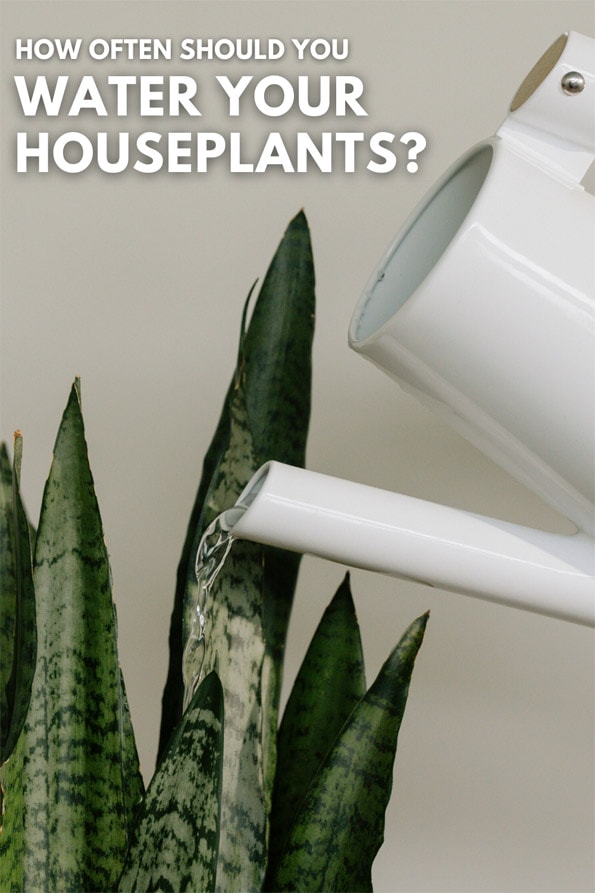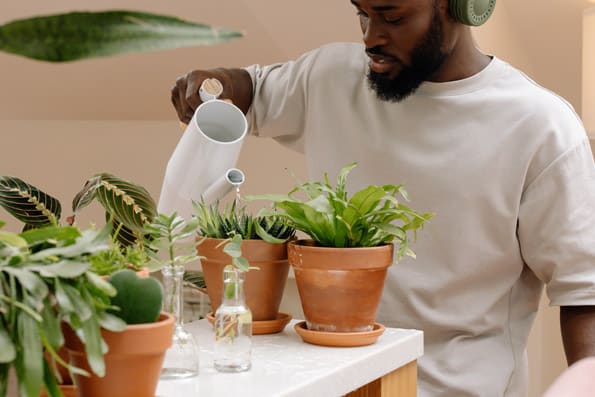Many houseplants want their potting soil moist during the Spring, Summer, and Autumn and just a bit drier during Winter. Very wet or saturated soil should usually be avoided
How often you need to reach for the watering can to achieve this goal depends. But as a rough rule of thumb, you can expect to water most plants once or twice a week during Spring, Summer, and Autumn and once a week or fortnight in Winter.
The right amount of watering is important because houseplants don't have access to natural water sources and therefore depend entirely on us. - Photo by cottonbro
How much water does my plant need? It is a question we're frequently asked. To answer this, you need to understand that with too little water, a houseplant will die - This is a fundamental principle of all plants. Whether it's filtered water applied early morning or tap water late at night, both will keep your plants alive.
But it's also true that with too much water, a houseplant will die. There is a balancing act to get right, but the first bit of good news is that most houseplants don't need it to be perfect all the time.
Don't worry too much.
A little too much water or not enough from time to time won't finish off most popular houseplants.
The second piece of good news is that we've already done most of the hard work for you!
All you need to do is look for your particular houseplant on our Plant Profiles page, where you'll learn its individual watering needs. We've got instructions from African Violets to the ZZ Plant and everything in between.
When you've understood this, there are Four Environmental Factors and Four Plant Factors to consider because these can all influence how much water a plant uses and therefore the time needed between waterings.

Hi, I'm Tom!
If you're like me and enjoy the challenge of growing houseplants and getting them to thrive, then Ourhouseplants can help. This website shares my knowledge and years of growing plants and provides (hopefully) helpful advice on properly caring for your indoor plant friends.
Depending on the plant type, sometimes it's easy to know when to get the watering can out, many houseplants are rather clever and tell you when they want water. The Peace Lily in the photo below for example is very obvious.
Use the slider below to tap / swipe back and forth to see the difference between a correctly watered and underwatered plant.
The plant on the left has the correct amount of water, the photo on the right shows the plant has dry soil and so doesn't have enough water.
The picture on the right is the Peace Lily telling you it really needs water. It's wilting and flopping over in a very dramatic and attention grabbing way. One look at it and you know something is wrong. The photo on the left shows its now got plenty.
Some other house plants that do this, are Fittonia, Lady Palm, and Purple Shamrock. Most however don't give such clear signs, but there are a few subtle hints you might be able to pick up on.
Winters tend to be cooler, with much less light filtering into your home. Plants know this and this is usually when they're the most inactive. Some will even go into a mini hibernation or "rest" period.
They might not be growing at all and barely using any water during this time.
There are no fixed rules here, but based on personal experience, the frequency of watering goes way down at this time of the year. Once every 7 to 28 days is considered normal for me.
Summers tend to be warmer, with loads more light filtering into your home. Plants will be most active at this time of the year because it's their growing season and will need moist soil constantly for best results.
If conditions are good they're be growing fast during Summer, using water quickly and they'll therefore be thirsty. Make sure you water thoroughly until water seeps out of the bottom of the pot.
Again no fixed rules to follow, but all my plants need regular watering once every 4 to 10 days during Summer.
These pots all have drainage holes to let excess water escape, which is perhaps the best way to ensure you have healthy plants - photo by cottonbro
Don't forget
As the temperature and light intensity goes up so does the need for water. An increase in both of these variables results in a more effective level of photosynthesis which in turn needs more water.
After owning and growing houseplants for almost two decades, I've noticed one thing. In 80% of cases, when one of the plants in my collection needs water, the rest do too.
Think about it. Almost every plant in my home (and probably yours too) will have very similar environmental factors. Similar temperatures, humidity and light levels, so it makes sense they will dry out at a similar time.
This makes it easy and very time efficient as it's just a case of whizzing around all my plants and watering them at the same time.
My Secret Tip - In 80% of cases, when one of the plants in my collection needs water, the rest do too.
However, around 20% of the time this doesn't happen. Some plants need a ton more water than others and will dry out super fast. Others are set in quite shady spots in my home. They take almost double the amount of time to dry out.
Regular fixed routines following a set schedule will never work long term so I don't recommend practicing this.
But the "when one has dried out the rest (might) have too" fast rule, is a good starting point for sure. Give it a go let me know what you think below. If you have a different method share that too.
Credit for snake plant being watered and for the man watering small plants - Cottonbro

